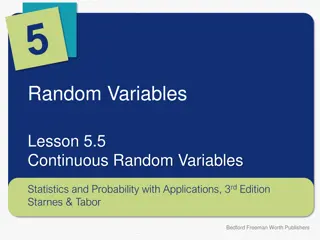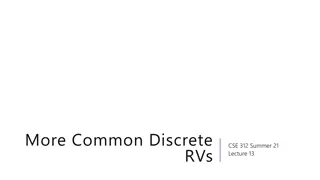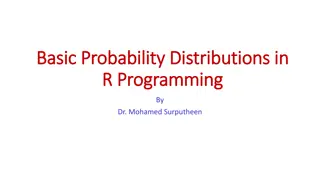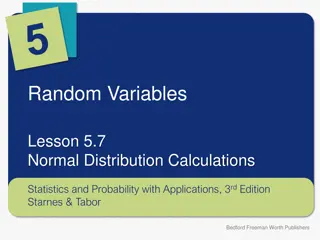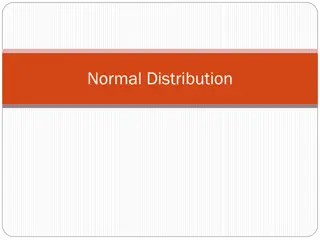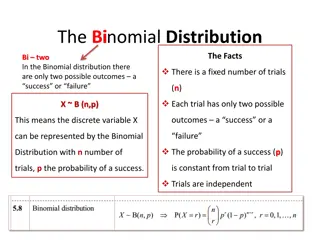Understanding Normal Distribution in Probability
Explore the properties and characteristics of the normal distribution, including the mode, symmetry, inflection points, and the standard normal distribution. Learn how to use standard normal tables to find probabilities and areas under the curve. Practice using examples to calculate probabilities based on standard normal values.
Download Presentation

Please find below an Image/Link to download the presentation.
The content on the website is provided AS IS for your information and personal use only. It may not be sold, licensed, or shared on other websites without obtaining consent from the author. Download presentation by click this link. If you encounter any issues during the download, it is possible that the publisher has removed the file from their server.
E N D
Presentation Transcript
CHAPTER FIVE SOME CONTINUOUS PROBABILITY DISTRIBUTIONS
5.1 Normal Distribution: The probability density function of the normal random variable X, withmean and variance is given by: 1( 2 X 1 2 ) = 2 ( , , f x ) , e x 2
5.1.1 The Normal Curve has the Following Properties: The mode, which is the point on the horizontal axis where the curve is a maximum, occurs at X= , (Mode = Median = Mean). The curve is symmetric about a vertical axis through the mean .
The curve has its points of inflection at X= is concave downward if - <X< + and is concave upward otherwise. The normal curve approaches the horizontal axis asymptotically as we proceed in either direction away from the mean. The total area under the curve and above the horizontal axis is equal to 1.
Definition: Standard Normal Distribution: The distribution of a normal random variable with mean zero and variance one is called a standard normal distribution denoted by Z N(0,1) Areas under the Normal Curve: X ( , ) N X = (0,1) Z N Using the standard normal tables to find the areas under the curve.
EX (1): Using the tables of the standard normal distribution, find: ( ) ( a P Z 2.11) ( ) ( b P Z 1.33) = ( ) ( c P Z 3) ( ) ( 1.2 d P 2.1) Z
Solution: ( ) ( a P Z = 2.11) 0.9826
( ) ( b P Z 1 0.0918 = = 1.33) 0.9082
( ) ( c P Z = = 3) 0 = 0.9821 0.1151 = ( ) ( 1.2 d P 2.1) 0.867 Z
EX (2): Using the standard normal tables, find the area under the curve that lies: A. to the right of Z=1.84 B. to the left of z=2.51 C. between z=-1.97 and z=0.86 D. at the point z= -2. 15
Solution: A. to the right of Z=1.84 ( 1.84) P Z = = 1 0.9671 0.0329
B. to the left of z=2.51 P Z = ( 2.51) 0.9940
C.between z=-1.97 and z=0.86 ( 1.97 = 0.8051 0.0244 = 0.86) 0.7807 P Z
D.at the point z= -2. 15 ( P Z = = 2.15) 0
EX (3): Find the constant K using the tables such that: (a) K = ( ) 3015 . 0 P Z Z . 0 = ( 18 ) 4197 . 0 P K (b)
Solution: (a) P K = ( ) 3015 . 0 Z = 3015 . 0 = = ( ) 3015 . 0 1 6985 . 0 . 0 52 P Z K k
(b) . 0 = ( 18 ) 4197 . 0 = P K Z 4197 . 0 4286 . 0 = k 0089 . 0 . 2 37
EX (4): Given a normal distribution with =50 , =10 . Find the probability that X assumes a value between 45 and 62. Solution: 45 50 (45 62) ( 10 0.8849 0.3085 = 62 50 = = ( 0.5 ) 1.2) P X P Z P Z 10 = 0.5764
EX(5) : Given a normal distribution with =300 , =50, find the probability that X assumes a value greater than 362. Solution: ) 362 ( = X P 362 300 = . 1 ( ) ( 24 ) P Z P Z 50 = = 8925 . 0 1 1075 . 0
EX (6): Given a normal distribution with =40 and =6, find the value of X that has: (a) 45% of the area left (b) 14% of the area to the right Solution: (a) 45% of the area left ( ) 0.45 P Z k = = 0.13 k 40 X = = = = ( 0.13) 0.45 0.13 0.78 40 39.22 P Z X X 6
(b) 14% of the area to the right 1 0.14 = 40 6 = 0.86 1.08 k X = = = = ( 1.08) 0.14 1.08 6.48 40 46.48 P Z X X
Applications of the Normal Distribution: EX (7): The reaction time of a driver to visual stimulus is normally distributed with a mean of 0.4 second and a standard deviation of 0.05 second. (a) What is the probability that a reaction requires more than 0.5 second? (b) What is the probability that a reaction requires between 0.4 and 0.5 second? (c ) Find mean and variance.
Solution: 0.4, X = = 0.05 X (a) What is the probability that a reaction requires more than 0.5 second? 0.5 ( ) ( 0.5) ( a P X P Z = 0.4 = ) ( 2) P Z 0.05 = 1 0.9772 = 0.0228
(b) What is the probability that a reaction requires between 0.4 and 0.5 second? 0.4 0.4 0.5 0.4 = ( ) (0.4 b P 0.5) ( ) X P Z 0.05 Z 0.05 = = = (0 2) 0.9772 0.5 0.4772 P
(c ) Find mean and variance. ( ) c = = 2 0.4, 0.0025
EX (8): The line width of a tool used for semiconductor manufacturing is assumed to be normally distributed with a mean of 0.5 micrometer and a standard deviation of 0.05 micrometer. (a) What is the probability that a linewidth is greater than 0.62 micrometer? (b) What is the probability that a line width is between 0.47 and 0.63 micrometer?
Solution: (a) What is the probability that a line width is greater than 0.62 micrometer? 0.5, 0.05 X X = = 0.62 ( ) ( 0.62) ( 0.05 1 0.9918 0.0082 = = 0.5 = = ) ( 2.4) a P x P Z P Z
(b) What is the probability that a line width is between 0.47 and 0.63 micrometer? 0.47 0.5 0.63 0.5 0.05 0.9953 0.2743 = = ( ) (0.47 b P 0.63) ( ) X P Z 0.05 = ( 0.6 = 2.6) 0.721 P Z
Normal Approximation to the Binomial: Theorem: If X is a binomial random variable with mean =n p and variance =n p q, then the limiting form of the distribution of = q p n X n p Z as n is the standard normal distribution N(0,1) .
EX (9): The probability that a patient recovers from rare blood disease is 0.4. If 100 people are known to have contracted this disease, what is the probability that less than 30 survive?
Solution: 100 , n = = = 0.4 , 0.6 p q = = = (100)(0.4) 40 , np = = = (100)(0.4)(0.6) 4.899 npq 30 4.899 40 = = = ( 30) ( ) ( 2.04) 0.0207 P X P Z P Z
EX (10) A multiple choice quiz has 200 questionseach with 4 possible answers of which only 1 is the correct answer. What is the probability that sheer guess work yields from 25 to 30 correct answers for 80 of the 200 problems about which the student has no knowledge?
Solution: = = = (80)(0.25) 20 , p np = = = (80)(0.25)(0.75) 3.873 npq 25 20 3.873 30 20 3.873 = = 2.58) 0.9951 0.9015 0.0936 = = (25 30) ( ) (1.29 P X P Z P Z



